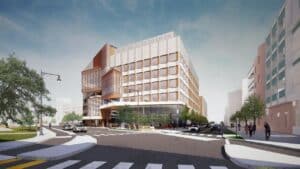
Life science leasing is retrenching to established industry clusters such as Cambridge as Greater Boston’s development pipeline dwarfs the requirements by tenants currently in the market. Moderna’s new 462,000-square-foot headquarters is under construction at 325 Binney St. in Kendall Square. Image courtesy of Alexandria Real Estate Equities.
Developers of an estimated 21 million square feet of life science projects in Greater Boston face a day of reckoning, including more than 5 million square feet of early-stage proposals that would break ground in a softening market and rampant competition for tenants.
As the venture capital industry becomes more conservative about investing in life science, tenant requirements for office and lab space are being dwarfed by the volume of projects proposed and under construction.
“Landlords need to be aggressive and get creative,” said Catie Tilton, a director at brokerage Newmark in Boston, at a NAIOP Massachusetts market forum last week. “They need to figure out how to make the building work, no matter what the requirement.”
Like house hunters that suddenly find desirable properties within their budget, biotechs are gravitating toward higher-end buildings and established industry clusters such as Cambridge, Boston’s Seaport District, Watertown and Lexington.
Supply-demand dynamics have shifted rapidly since 2021, when tenant demand peaked at 8.9 million square feet, including 2.4 million square feet of cGMP facilities, according to Newmark research.
The market was so overheated in 2021 that one developer, Boston-based Marcus Partners, landed a 150,000-square-foot anchor lease for a Seaport District project four months before it was approved by the Boston Planning & Development Agency. Ginkgo Bioworks later leased the entire 219,000-square-foot Foundry at Drydock development on Anchor Way.
In today’s sparser tenant landscape, total requirements are 1.9 million square feet, including 900,000 square feet of biomanufacturing space, according to Newmark.
The downturn isn’t reflected in a historic development pipeline which is scheduled to deliver 21 million square feet of new life science space. About three-quarters of the projects are already under construction, with another 5.5 million square feet proposed.
Companies also are listing 1.9 million square feet of lab space for sublease, while landlords have built out 1.3 million square feet of move-in-ready spec space.
“So, what does this mean? There are too many options,” Tilton said.
New Markets Fade from Radar
Developments in areas without established life science clusters face the stiffest headwinds, brokers predict.
Two high-profile lab projects have already hit turbulence in Newton, a city that only entered the conversation as a life science cluster after officials approved more lab-friendly zoning in 2021.
Alexandria Real Estate Equities is selling its Riverside Center office park, previously planned for a lab conversion, after recording a $139 million impairment on the property it bought for $235 million in 2020. And Newton-based Mark Development previously announced a delay in its 1 million-square-foot life science-focused project on a portion of the MBTA’s Riverside station property, due to weakening economic conditions.
Major life science projects currently under construction that haven’t announced any tenant commitments to date include Boston Global Investors’ 600,000-square-foot 10 World Trade Center office-lab tower in Boston, Greystar’s 465,000-square-foot 74M tower in Somerville and BioMed Realty’s 495,000-square-foot office-lab tower at Assembly Innovation Park.
Financing Delays Sideline Commitments
For now, developers are continuing to seek approval for large-scale lab projects in a still-widening assortment of communities and neighborhoods. Just in the last two weeks, Malden-based Combined Properties this month proposed a 1.2 million-square-foot life science campus on Medford’s Mystic Avenue, while longtime office building owner KS Partners last week proposed an 11-story lab tower in Boston’s Bulfinch Triangle.
But the demand landscape has cooled and with it, the chances of successful lease-ups. The road to financing and groundbreaking is becoming trickier, particularly for speculative projects.
Tenants still in the market are favoring purpose-built lab buildings over office-to-lab conversions, and developers are subdividing spaces to as little as 10,000 square feet, reflecting smaller average space requirements.

Steve Adams
Biotechs that were scouting lab spaces for expansion while confidently awaiting venture funding now are conserving cash for research rather than real estate, brokers said.
“They started out anticipating a series A round, that round has been delayed, and the real estate [expansion] has also been delayed,” Tilton said.
Email: sadams@thewarrengroup.com




 |
| 